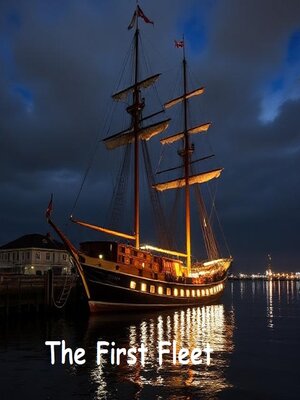
Sign up to save your library
With an OverDrive account, you can save your favorite libraries for at-a-glance information about availability. Find out more about OverDrive accounts.
Find this title in Libby, the library reading app by OverDrive.



Search for a digital library with this title
Title found at these libraries:
| Library Name | Distance |
|---|---|
| Loading... |
The First Fleet refers to the group of eleven ships that departed from Portsmouth, England, on 13 May 1787, bound for Botany Bay, New South Wales, with the mission of establishing the first European colony in Australia. This historic voyage marked the beginning of British colonisation of the continent and had profound consequences for both British society and the Indigenous peoples of Australia.
The fleet carried approximately 1,400 people, including around 780 convicts (men, women, and children), a detachment of Royal Marines, and a number of officers, seamen, and officials. The fleet was under the command of Captain Arthur Phillip, who was appointed Governor of the new colony. The decision to establish a penal colony in Australia stemmed from several factors: overcrowded British prisons, the loss of the American colonies (which had previously received transported convicts), and strategic and economic interests in the Pacific.
The journey to Australia took over eight months, covering more than 24,000 kilometres. The ships travelled via Tenerife, Rio de Janeiro, and the Cape of Good Hope, where they resupplied. Despite the length and difficulty of the voyage, the fleet arrived with relatively few deaths—around 48 people died during the passage, a number considered low by the standards of the time.
The fleet arrived at Botany Bay between 18 and 20 January 1788, but Phillip quickly determined that the site was unsuitable for settlement due to poor soil, lack of fresh water, and exposure to open seas. He explored northward and found Port Jackson, where the natural harbour and freshwater streams made for a far better site. On 26 January 1788, the fleet relocated to what would become Sydney Cove, marking the official foundation of the colony of New South Wales.
The arrival of the First Fleet had devastating consequences for the Indigenous Eora people, who had lived in the Sydney area for thousands of years. The British did not negotiate for land, and their presence led to conflict, displacement, and the spread of European diseases. Within decades, traditional ways of life were disrupted, and many Aboriginal communities were decimated.
Life for the settlers was harsh. The early years of the colony were marked by food shortages, isolation, and the struggle to adapt to a new environment. The skills needed to cultivate the land were lacking, and supplies from Britain were slow in coming. Governor Phillip showed resilience and pragmatism, working to maintain order and foster relationships with local Indigenous groups, though tensions remained high.
The legacy of the First Fleet is complex. For many Australians of European descent, it represents the beginning of modern Australia. For Indigenous Australians, it marks the start of invasion, dispossession, and a long struggle for recognition and justice. Today, 26 January, the date of the fleet's arrival at Sydney Cove, is observed as Australia Day, though it remains a day of mourning and protest for many Aboriginal and Torres Strait Islander peoples.







